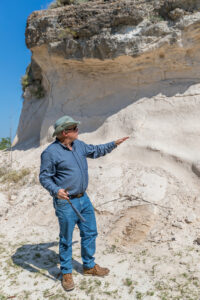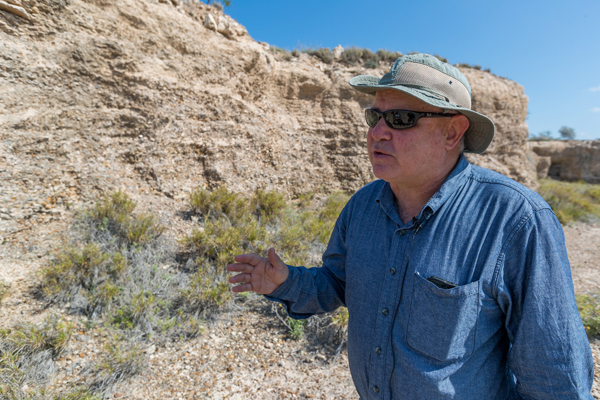- La Feria Community Holds Succesful Business Mixer Event
- Little Nashville to Take Place in Downtown Mercedes
- Lions Basketball Captures District Gold
- La Feria ISD Students Compete in Regional Chess Tournament
- Lions End First Half of 32-4A on a High Note
- La Feria ISD Held Another Successful Parent Conference
- Strong Appearance for Lions at Hidalgo Power Meet
- LFECHS Students Get to Meet Local Actress
- Students Participate in Marine Biology Camp
- Two LFECHS Students Qualify for All-State Band
Missing: Millions of Years of RGV History
- Updated: June 1, 2018
UTRGV professor researching geological mysteries
by Maria Elena Hernandez
 RIO GRANDE VALLEY, TEXAS – For geologist Dr. Juan González, time travel is a simple road trip along Expressway 83.
RIO GRANDE VALLEY, TEXAS – For geologist Dr. Juan González, time travel is a simple road trip along Expressway 83.
“The further west you go, the further back in time you go,” said González, a UTRGV associate professor in the School of Earth, Environmental, and Marine Sciences (SEEMS).
The rocks on the UTRGV Edinburg Campus are 1.8 million years old. Traveling west into Starr County, you’ll hit the Goliad Formation, which is 5 million to 7 million years old. By the time you reach the Roma cliffs, you’re at what was a beach environment 43 million years ago.
“I was driving to the Rio Grande Valley from New Orleans (in 2009), and all I saw was flat coastal plain, and I figured there is not much here,” González said. “But shortly after, they took me on this field trip and it was an eye opener.”
That’s because González, a Quaternary geologist, could see volcanic ash along the formations, which are millions of years old.
Yes, volcanic ash. In the Rio Grande Valley.
“Now, do you know of any volcanoes nearby?” he said rhetorically.
“I started researching the literature for any information on the ash,” he said, “and nothing has been done. Nothing. I could not find a single reference to this outcrop.”
The sediment is now clay, he explained, but the clay originated from volcanic ash.
“This light color has a very unique composition. This was from a magma that was very viscous,” he said. “It could not flow. So when the caldera of the volcano exploded, it exploded violently.”
In fact, the explosion was so violent it left a layer of volcanic ash that’s 20 meters thick (almost 66 inches). And it did it in a single eruption.
“This clearly caused climate change,” González said. “Some species might have gone extinct.”
While González and his colleagues debate whether the ash fell within a few days or months, they have verified the age of the formation, called the Catahoula Formation. Two independent labs have calculated that the formation is about 27.2 million years old.
With that information, they’re working to find the source of the volcanic ash, which extends south into Mexico and north toward Three Rivers.
“We have good candidates. With that age, we can go back and see, based on previous work, what volcanoes were active at the time,” González said.
However, the age verification of the Catahoula Formation with volcanic ash is part of another mystery. The Goliad Formation above it is 5 million to 7 million years old.

Dr. Juan González, a UTRGV associate professor in the School of Earth, Environmental, and Marine Sciences (SEEMS) and a Quaternary geologist, says there is a puzzling geological formation about 27 million years old called the Catahoula Formation in Starr County. The deposit is clay now, but it originated from volcanic ash. The riddle for geologists is, if there are no volcanoes near Starr County, where did this 66-foot deep deposit of volcanic ash come from? Capping the volcanic ash formation is the Goliad Formation, dated at 5 million to 7 million years old. González and associates now are trying to find out what happened to the 20 million years of history between the two formations. Photo: David Pike/UTRGV
So, what happened to the 20 million years between the two formations?
“We don’t know what happened,” González said. “Whatever was there was lost, washed away and lost for good.”
And while that may have disappeared, there is still much more research to do on the geological formations in the Rio Grande Valley, he said.
“We argue that when this ash was raining down, the shoreline must have been very close to where we are (in Starr County),” González said. “I’m interested in hopefully one day finding the fossil of a fish.”
Access to the geological sites is not limited to professors. UTRGV students also take field trips, usually at the end of a semester, to study the formations.
“Clearly, there is a lot of interesting geology,” González said.
You can learn more about the research at the UTRGV School of Earth, Environmental, and Marine Sciences by visiting UTRGV.edu/SEEMS.
ABOUT UTRGV
The University of Texas Rio Grande Valley (UTRGV) was created by the Texas Legislature in 2013 as the first major public university of the 21st century in Texas. This transformative initiative provided the opportunity to expand educational opportunities in the Rio Grande Valley, including a new School of Medicine, and made it possible for residents of the region to benefit from the Permanent University Fund – a public endowment contributing support to the University of Texas System and other institutions.
UTRGV has campuses and off-campus research and teaching sites throughout the Rio Grande Valley including in Boca Chica Beach, Brownsville (formerly The University of Texas at Brownsville campus), Edinburg (formerly The University of Texas-Pan American campus), Harlingen, McAllen, Port Isabel, Rio Grande City, and South Padre Island. UTRGV, a comprehensive academic institution, enrolled its first class in the fall of 2015, and the School of Medicine welcomed its first class in the summer of 2016.


